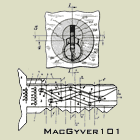mhole wrote:? I fail to see how the bitting of a key which has 10 wafers, each a possible 4 heights, can be encoded in a 6 digit number.
There may be two possibilities.
If I recall correctly, Ingersoll locks don't have any MACS restriction, which means that any of the 4 possible heights can be used in any of the 10 wafer positions. If so, there are ( 4^10 = 1,048,576 ) possible key cuts -- which is more than the 1-million cuts you could encode in a six-digit number (000000-999999), but not
that many more (not quite 5%).
The first scenario I could imagine is that, even with no MACS restriction, they might have some factory coding rules that restrict things, like:
- the amount of repitition in the biting (e.g., they probably won't allow keys cut to "1111111111", "222222222", "1212121212", etc.);
- they may have limits on adjacent shallow cuts in the first position(s), so as not to weaken the key;
- they may prohibit cuts like "1111223333" that could end up with a key that can be accidentally pulled out of the lock when the cylinder's only partially rotated.
A few restrictions like those could easily eliminate 5% of the possible keys, which gets you down into the million-keys / six-digits territory.
The alternative is that they may also be encoding the biting into the letter in the key code. I only have one Ingersoll lock, so I only have one sample key code to look at -- but it has a letter in the middle (144S868). I'm assuming that the "S" describes the keyway... but if you had two letters for every keyway you could encode 2-million possible keys with the numbers and letters -- which is far more "space" than you'd need. However, that seems like it would be awkward: nobody would want to keep remembering that "S" and "T" blanks were actually the same? I think the first situation is more likely.
So, that doesn't get you any closer to knowing how Ingersoll generates their key codes -- but I would believe that, with a few simple factory restrictions on disallowed combinations, you could easily have a direct mapping between every "permitted" cut and a unique 6-digit number.
If that's all true, and if they didn't make any effort to shuffle the actual key cuts before numbering them, then it might not be that hard to guess at the factory restrictions and reverse-engineer their mapping.




